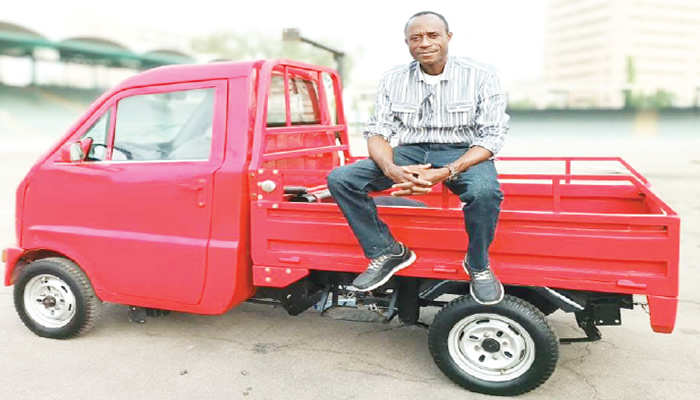
A PhD student at the University of Benin, Edo State, Eghosa Igbinosa, who built a lightweight truck for conveying goods from locally-sourced materials, tells GODFREY GEORGE how he was able to do so
You recently built a lightweight vehicle as part of your PhD requirement. What really inspired the project?
I have always wanted to find solutions to problems in my immediate environment. In a world of fast-developing countries, there is a need for improvement in the manufacturing processes and agricultural production methods. This will lead to an increased volume of goods to be transported. In many Nigerian cities where the use of tricycles is prevalent, you will discover that these tricycles, which were originally meant to convey human passengers, are now being converted to unsafe cargo or utility vehicles to transport goods. This is done by extending its longitudinal length or rear overhang far beyond the rear wheel of the tricycle and building a carriage facility on the roof of the tricycle, making it laterally stable.
This act of reconstructing the vehicle to attempt to serve the purpose of transporting goods is an indication that there is a level of inadequacy in transportation needs for a large group of people such as traders, small and medium scale business owners and local farmers.
Transportation, being so vital to the development of any nation, it became very imperative for me to develop a local utility vehicle using locally-sourced materials and technology.
What were some of the challenges you faced building this mini-truck and how did you get the funds to do this?
I encountered a lot of challenges while working on the project, including the unavailability of the right equipment required for design and fabrication of the vehicle and its components.
The project was 100 per cent privately funded by me. The expenditure on the development of the utility vehicle includes the procurement of all the basic workshop tools needed for construction, materials for the fabrication of the vehicle parts, the tooling cost in producing simple jigs and fixtures, and, of course, the cost of running the power generator and providing logistics while working on the project.
How long did it take for you to finish the project?
It took about 36 months to complete the vehicle. This includes the development and construction. I spent that long mostly due to the fact that construction works were done only on weekends. I am sure it may have taken less time to complete the fabrication of the vehicle if its construction works were done daily.
Were all the components of the vehicle sourced locally?
The lightweight utility vehicle was largely produced from 67 per cent original, locally-manufactured automobile components.
The original components locally-produced for the manufacturing of the utility vehicle include the entire body (cabin, doors and cargo bay) of the vehicle, chassis, the suspension and wheel assembly (spindles, hubs, knuckles, lower control arms) components , dashboard, seats, etc.
Modified existing automobile parts used in the vehicle make about 13 per cent of the vehicle components. These include the rack and pinion steering box and column, windscreen, door glass, door key mechanism, instrument cluster unit, etc. Therefore, 80 per cent of the components of the vehicle were locally made. However, an estimated 20 per cent of the vehicle parts were sourced from donor vehicles and used directly. These parts include the engine/gear box bearings, axle, etc.
How much did you spend from start to finish and how did you source the funds?
The sum of N1.2m was spent on the vehicle development and the fund was from my personal savings
How has the reception been?
From the comments I have read on some of the publications on the work, I can say that the reception has been great. Very many people are excited and have accepted the utility vehicle as a Nigerian-made vehicle and they wish the utility vehicle can be mass-produced immediately. I am encouraged and happy about the development. (All) glory be to God!
What is the capacity of this vehicle?
The lightweight (600kg) utility vehicle has maximum load capacity of one ton (1,000kg) and designed top speed of 75 km/hr.
Due to the geometric dimensions of the vehicle, the wheel length is about 2,145mm and it has a width track of 1,200mm. The vehicle has the advantage of being able to access areas that bigger truck cannot get to, making it applicable for use on narrow farm roads.
Another striking advantage of this model of the vehicle is that it fitted with a 8.5KW IC engine similar in design to the types you can find in some motor bikes. What this means is that it makes the vehicle to have low-cost maintenance, low fuel consumption and it can be repaired easily by both motor bike and auto mechanics.
Is this what you do for a living originally?
Well, yes. I am self-employed and I engage in general engineering practice. I am a PhD student of Engineering at the University of Benin, Edo State.
Has studying Engineering always been your dream?
Yes, I have always wanted be an engineer and that passion or dream was evident in the things I was involved in while growing up.
What kind of growing up did you have?
Growing up in Benin City, Edo State can be described as an interesting one. Though my late parents were not the wealthy type, my sibling and I were properly guided by them to be who we are today. As a kid, I spent most of my playtime trying to make my own toys. I remember making my own cars and airplanes since my siblings and I were not fortunate enough to have already-made toys from the big superstores.
Was there any time in your academic pursuit that you almost gave up on your dream?
Yes, of course. While in pursuit of my education, I had a lot challenges which at some points were capable of stalling my dreams but God Almighty saw me through them all.
Firstly, my father (who is late dead) retired from the civil service the year I gained admission to the University of Benin to pursue a degree in Bachelor in Engineering, in Production Engineering. This made my access to fund very limited. I only had two textbooks of my own in my five years of study. Twice I begged one of my lecturers, Prof. Ibhadode, for money to feed. As God would have it, he is the supervisor of this current project I embarked on.
Secondly, my M.Eng was hard because I had to work and study at the same time for my exams. As for my PhD dream, sometime ago I secured admission for PhD and commenced research work but dropped out because I couldn’t combine work and the workload of the research. It didn’t deter me; I purchased a new form the following year but never had time to process it because I was out on a fieldwork. I had to buy another form the third time, which I could not process for the same reason as the second. It seemed like it was not going to be possible, but to the glory of God Almighty, I am currently in the concluding phase of my PhD. The PhD research work on the lightweight utility vehicle made it the fourth time I attempted a PhD study.
What do you intend to do after your PhD?
At the moment, I have ruled out the possibility of being in the classroom any time in the future. However, I am looking forward to mass-producing this model of the vehicle and other models after my PhD.
What kind of support will you need to mass-produce this vehicle?
At this stage of the vehicle development, I need technical and financial partners to join me. I will like to use this opportunity to call on the government, private sector and individuals to team up with me to mass-produce the current model of the vehicle and other versions of the vehicle, including other designs of electric and IC-powered cars and buses as well. I will love them to carry out research work in other areas such as aeronautics, where I am also very proficient.
Do you think the Nigerian government has been supportive of manufacturers?
The government has been supportive but I believe it can do better than what it has done so far to support manufacturers in Nigeria. Particularly, I will like to see a situation where the government will formulate more favourable policies to protect indigenous manufacturers from stiff competitions with their foreign counterparts and also create access to foreign exchange, reduction or wavier of import duties on spare parts, materials and specialised machines for indigenous manufacturers in Nigeria, among others.
How rewarding has engineering been for you?
The benefits has been huge and can be better if the Nigerian government will fully support engineering practice in Nigeria by providing the enabling environment for general engineering practice. Making fund available for research work can be one way to achieve this.
What advice do you have for government concerning teaching Science, Technology, Engineering, and Mathematics to young children?
Concerning the teaching of Science, Technology, Engineering, and Mathematics in the context of educational policy in Nigeria, the government can make the policy more effective by intensifying the teaching of these four areas of study alongside massive practical sections and assignments in primary and secondary school across Nigeria. This can help to stimulate the young Nigerian students to be innovative and focused on creating technologies and scientific ideas.





